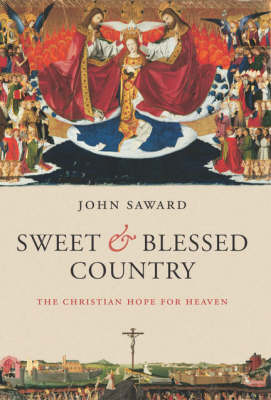|
Sweet and Blessed Country
The Christian Hope for Heaven
By John Saward

Was Published on 29th September 2005 in hardback, at £12.99 (UK).
OUP, 208pp, hbk
ISBN: 0 19 928009 6,
Paperback expected in April 2008
The subject of Heaven is largely ignored by academic theology today, yet
has an undeniable, deep popular resonance. In Sweet and Blessed Country, John Saward discusses the theology of the Heaven based on Enguerrand Quarton’s inspirational painting
Coronation of the Virgin.
Saward’s book is an exploration of Heaven, taking Quarton’s painting as a
starting point to explore the teachings of the Carthusian monastery where the painting originally hung. He shows
how the image expresses in colour and figure what the great monastic theologians – both medieval and modern - expressed
in concepts and words.
This book breaks new ground not just in terms of content, but also in style
and method. Discussing the often neglected area of eschatology (the doctrine of the last things), it opens new
paths for theological research and debate. Though Saward observes all the disciplines of scholarship, he also manages
to reach a readership beyond the academy.
Sweet and Blessed Country,
while faithfully rooted in the Catholic tradition, offers enlightenment to every Christian who seeks understanding
of their hope for Heaven, and encouragement to every human being who yearns for ultimate fulfilment.
The Rev’d Father John Saward is a Fellow of Greyfriars
Hall, Oxford, and priest for the Archdiocese of Birmingham. Having been ordained an Anglican priest before his
conversion to Catholicism, he received special dispensation from Pope John Paul II, to become one of the few married
Catholic priests. He is the author of seven books, and lives with his family in Oxford.
|
For
more information, or to interview John Saward, please contact Kirsty McHugh on 44 (0) 1865 353344, or kirsty.mchugh@oup.com.
Book Review on website owned by Forward
in Faith Movement. http://trushare.com/0128JAN06/JA06art.htm
(I want to thank the website owners for permission to reproduce the review below.)
Readers familiar with Fr Saward’s previous writings will know how he goes about his task: he takes as his theme
a particular doctrinal topic, states the fundamental framework of dogmatic definition and magisterial declaration,
elucidates the matter in hand according to the mind of St Thomas Aquinas, and then clothes it with a more devotional,
even mystical apprehension perceived through the commentary of chosen doctors and accompanied by the contemplation
of sacred art.
Redeemer in the Womb and Cradle of Redeeming Love unfolded the mystery of
the Incarnation in conversation with the piety of the French School inspired by Pierre de Bérulle; Sweet and Blesssed Country, composed as a series
of addresses to the Benedictine community at Pluscarden, is more consciously monastic in its orientation and chooses
Denys the Carthusian and Blessed Columba Marmion as its guides to the Dantesque landscape of the afterlife. That
landscape is explored through reflection on Enguerrand Quarton’s painting of the Coronation of the Virgin, made to a precise specification
for the Charterhouse of Villeneuve-les-Avignon in 1453.
Saward presents his case with a characteristic papalist machismo, relishing the maturation of his subject matter in the locus of fifteenth century Latin theology and devotion, and giving us rather a lot of Leo XIII
and Pius XII as a nod to modernity (incidentally, he is happier than he was in Cradle
of Redeeming Love with the teaching of John Paul II on the beatific vision
enjoyed by the human soul of the incarnate Christ before the Resurrection). But he enjoys with the late Herbert
McCabe the talent of expressing scholastic theology in lucid English, and this book is an excellent primer for
the authentic Catholic doctrine of the Last Things, and an eloquent rebuke to those who neglect to meditate on
them. Although its title suggests that it is exclusively concerned with the Christian hope for heaven, and although
this hope and the doctrines of the beatific vision and the resurrection of the dead are explained with great cogency,
the book contains substantial expositions of the atonement, purgatory, hell and the continuing maternal mediation
of Our Lady.
Occasionally the reader gets the impression that Fr Saward is there with his search-light where St Paul only managed
to see through a glass darkly: the two pages on whether the heavenly intercession of Christ is vocal or not left
me bemused, and though he is content to state following the schoolmen that the fire of hell is material, he does
not confront whether this means it is therefore locatable (and visitable?) within the universe. But these caveats
do not detract from the essential quality and distinction of a book which accomplishes a fine articulation of authentic
Catholic doctrine, burnishes to good effect the neglected spiritual acumen of both Denys the Carthusian and Blessed
Columba, and unconsciously demonstrates the remarkable identity of teaching on the afterlife shared by the unsound
Avignonese Pope John XXII and the current Bishop of Durham. The Oxford University Press has published this book
in a fine and attractive binding, but the reproduction of Quarton’s painting is too small to illustrate all the
points discussed in the text.
Robin Ward is the Vicar of St John’s, Sevenoaks
This version: 7th January 2008
|
